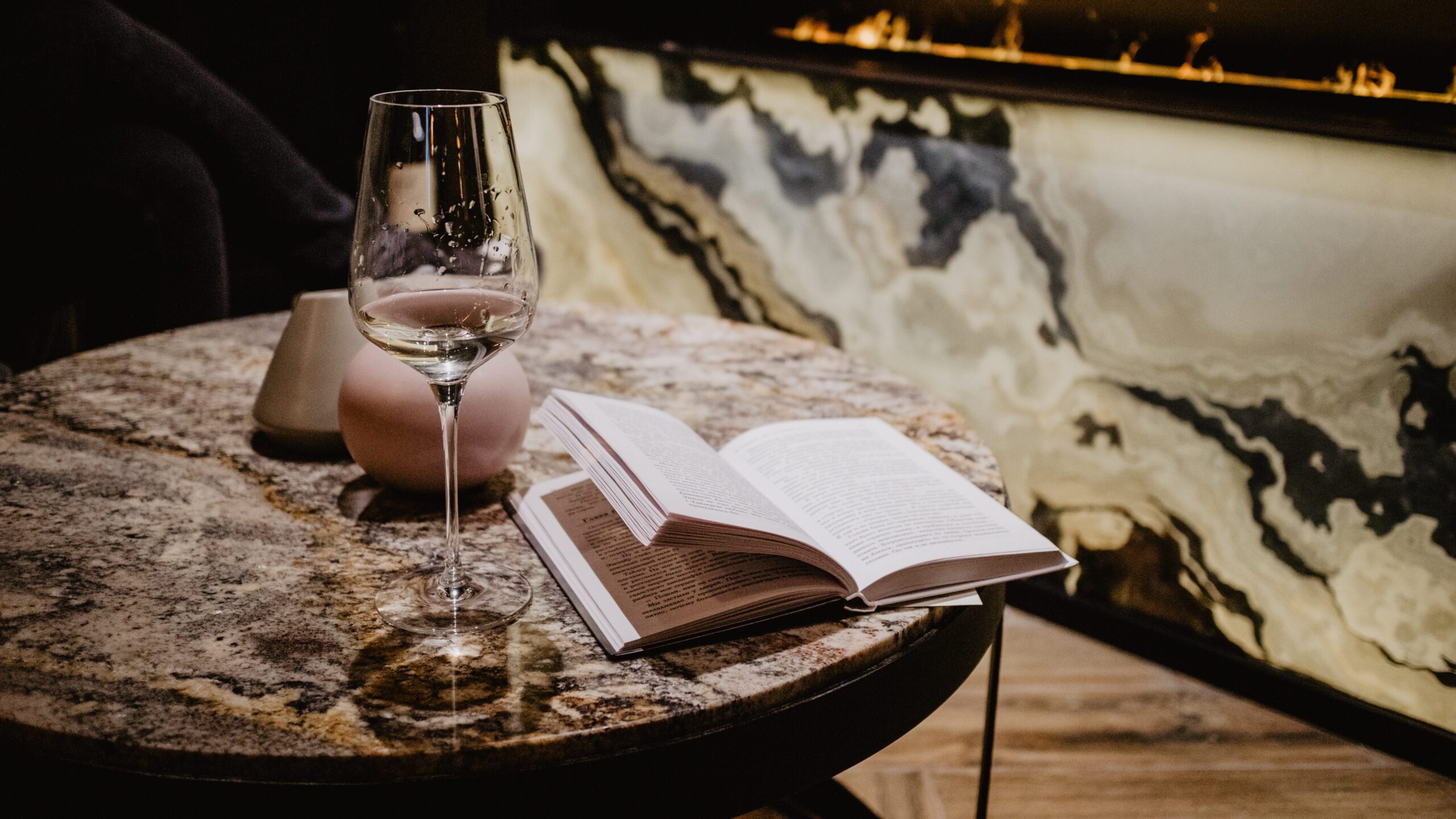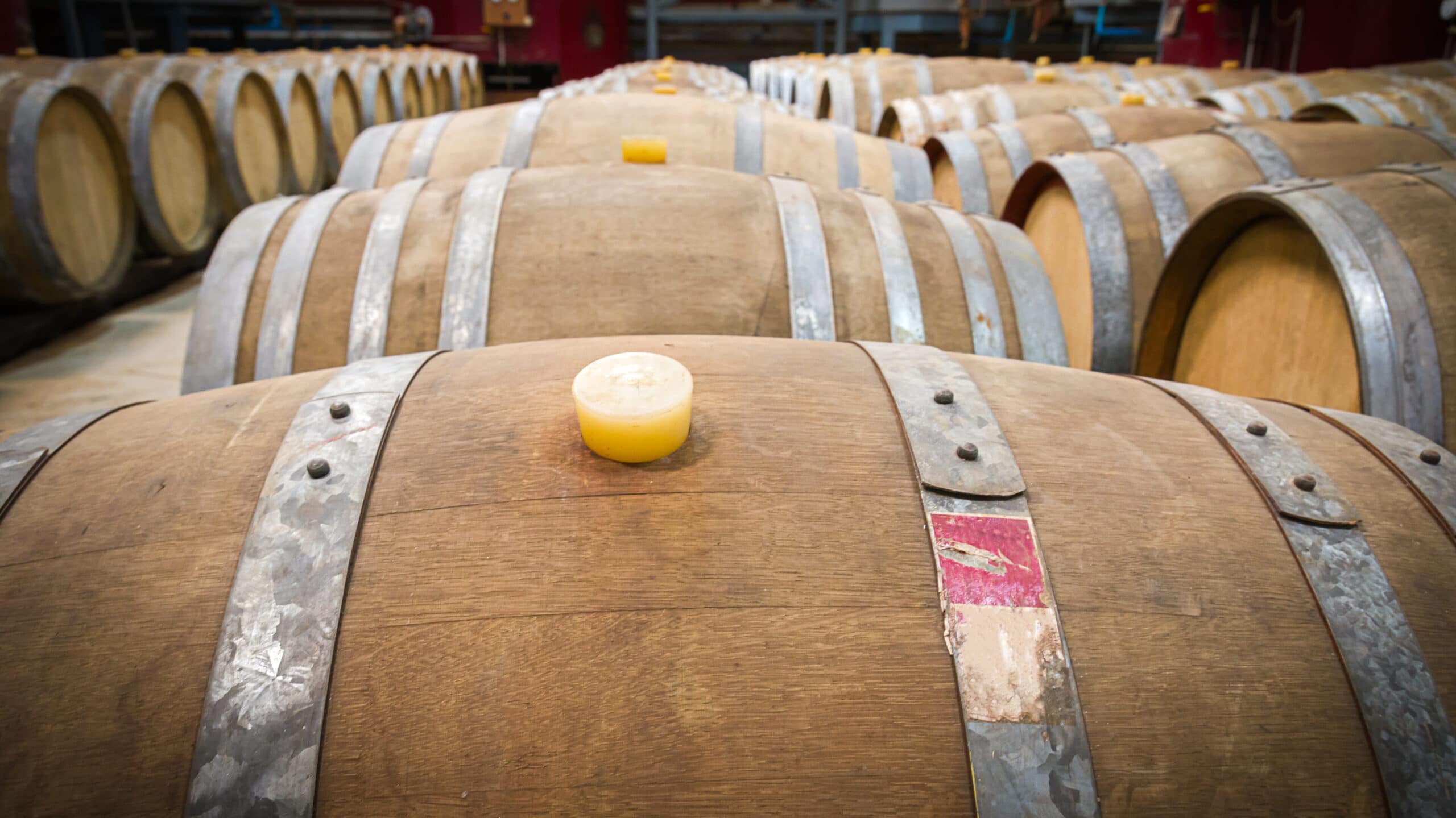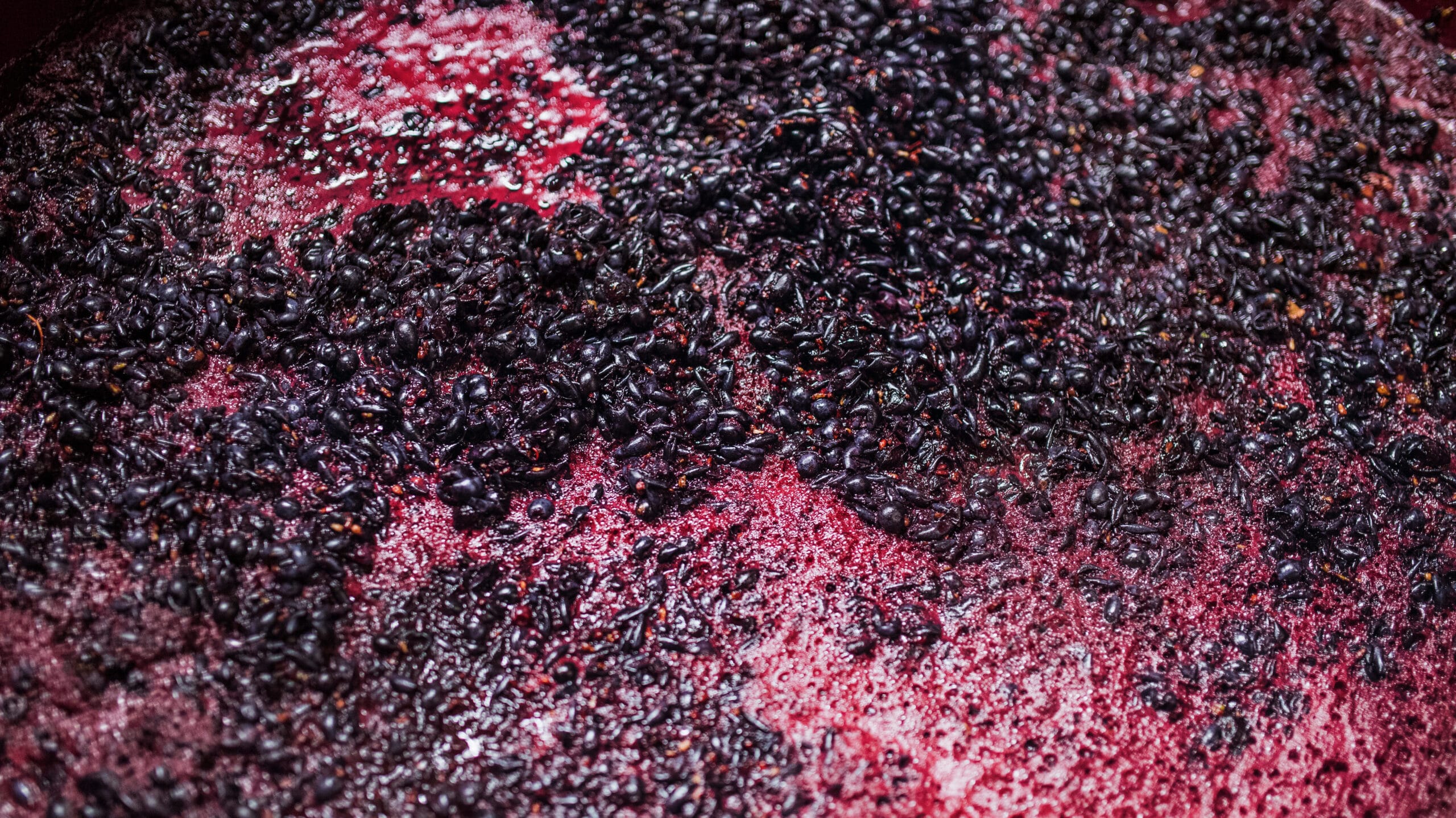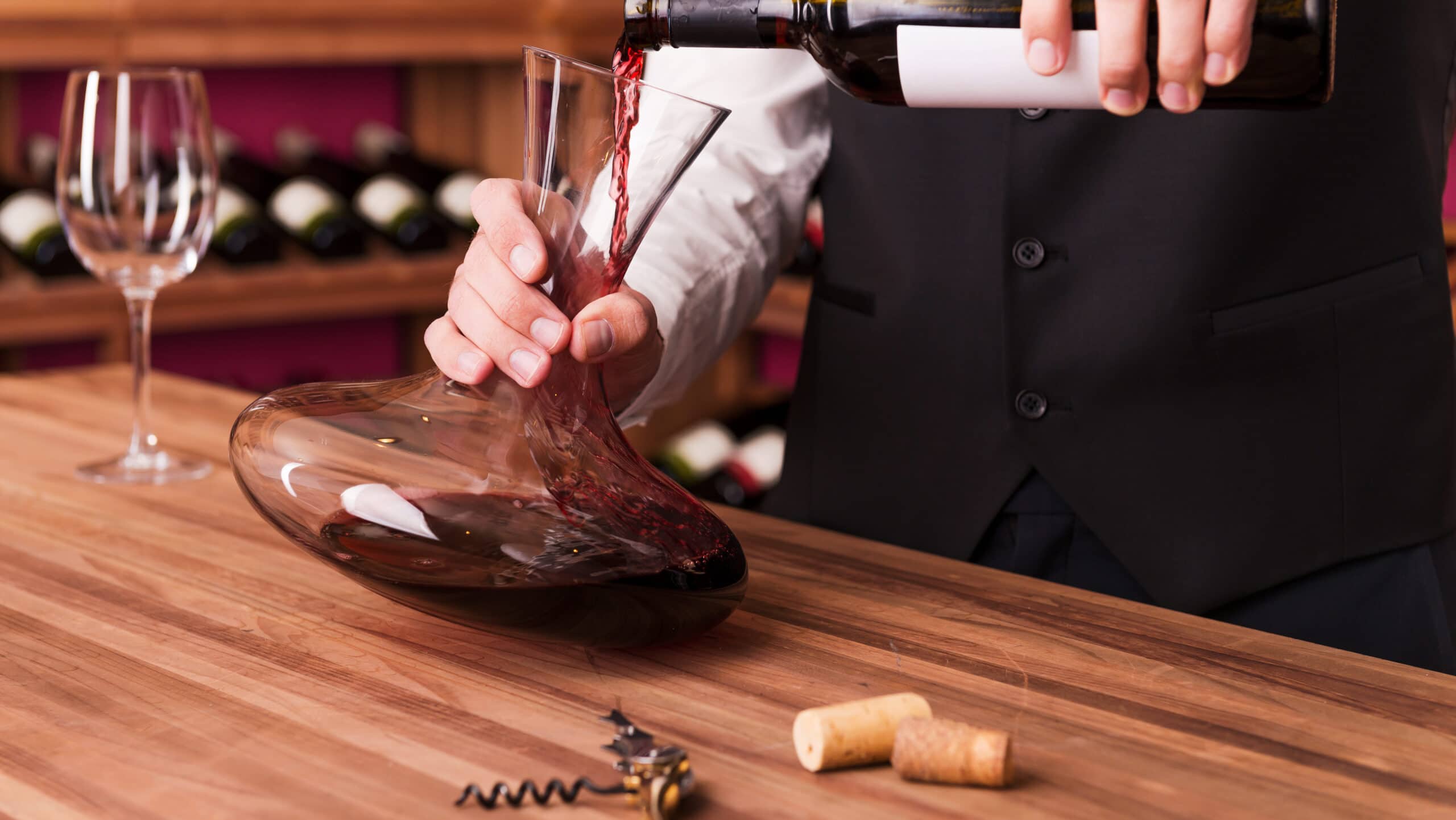We created this glossary of wine terms for all wine lovers, especially our wine students. You can find the most common wine terms and their definitions in this wine dictionary.

Our Wine Dictionary
Dictionary Index
Acidity to Astringent
acidity — the liveliness and crispness in wine that activates our salivary glands
aeration — the deliberate addition of oxygen to round out and soften a wine
aging — holding wine in barrels, tanks, and bottles to advance them to a more desirable state
alcohol — ethanol (ethyl alcohol), the product of fermentation of sugars by yeast
anosmia — the loss of smell
appellation — a legally defined region known to produce fine wine. See wine regions of the world.
aroma — the smell of wine, especially young wine (different than “bouquet”)
astringent — tasting term noting the harsh, bitter, and drying sensations in the mouth caused by high levels of tannin
Balance to Bunghole
balance — a term for when the elements of wine – acids, sugars, tannins, and alcohol – come together in a harmonious way
barrel — the oak container used for fermenting and aging wine
barrique — a 225-liter oak barrel used originally for storing and aging wines, originating in Bordeaux
bitter — a taste sensation that is sensed on the back of the tongue and caused by tannins
Blend — a wine made from more than one grape varietal
body — a tactile sensation describing the weight and fullness of wine in the mouth. Wine can be light, medium, or full-bodied.
Bordeaux — the area in Southwest France is considered one of the most significant wine-producing regions in the world. See French wine regions.
Botrytis — a beneficial mold that pierces the skin of grapes and causes dehydration, resulting in natural grape juice exceptionally high in sugar. Botrytis is largely responsible for the world’s finest dessert wines. (see “noble rot”)
bouquet — a term that refers to the complex aromas in aged wines
breathing — exposing the wine to oxygen to improve its flavors (see “aeration”)
Brettanomyces — a wine-spoiling yeast that produces barnyard, mousy, metallic, or bandaid-ish aromas
brilliant — a tasting note for wines that appear sparkling clear
brut — French term denoting dry champagnes or sparkling wines
bung — the plug used to seal a wine barrel
bunghole — the opening in a cask in which wine can be put in or taken out

Bunghole
Cellar to Cuvée
cellar — a temperature and humidity-controlled facility to store wine. See cellaring wine.
Chaptalization — adding sugar to wine before or during fermentation to increase alcohol levels. Chaptalization is illegal in some parts of the world and highly controlled in others.
citric acid — one of the three predominate acids in wine
claret — the name the English use when referring to the red wines of Bordeaux
class growth — see Cru classe
closed — a term describing underdeveloped and young wines whose flavors are not exhibiting well
CMS — the Court of Master Sommeliers. See sommelier courses in America
complex — a wine exhibiting numerous odors, nuances, and flavors
cork taint — undesirable aromas and flavors in wine often associated with wet cardboard or moldy basements
corked — a term that denotes a wine that has suffered cork taint (not wine with cork particles floating about)
corkscrew — a device to remove a wine cork that includes a handle, worm, and lever. See: the seven types of corkscrews

Corkscrew
cru classé — a top-ranking vineyard designated in the Bordeaux Classification of 1855
crush — the English term for harvest
cuvée — in Champagne, a blended batch of wine
Demi-sec to Full-bodied
demi-sec — French term meaning “half-dry” used to describe a sweet sparkling wine
dry — a taste sensation often attributed to tannins and causing puckering sensations in the mouth; the opposite of sweet. See wine tasting 101.
earthy — an odor or flavor reminiscent of damp soil
enology — the science of wine and winemaking (see “oenology”)
fermentation — the conversion of grape sugars to alcohol by yeast. See winemaking 101.

Fermentation
fining — the addition of egg whites or gelatin (among other things) to clear the wine of unwanted particles
finish — the impression of textures and flavors lingering in the mouth after swallowing wine
flavors — odors perceived in the mouth
foxy — a term that describes the musty odor and flavor of wines made from Vitis labrusca, a typical North American varietal
fruity — a tasting term for wines that exhibit strong smells and flavors of fresh fruit
full-bodied — a wine high in alcohol and flavors, often described as “big.”
Herbaceous to Must
herbaceous — a tasting term denoting odors and flavors of fresh herbs (e.g., basil, oregano, rosemary, etc….)
hot — a description of wine that is high in alcohol. See wine tasting 101.
lees — sediment consisting of dead yeast cells, grape pulp, seed, and other grape matter that accumulates during fermentation
leesy — a tasting term for the rich aromas and smells that result from wine resting on its lees
length — the amount of time that flavors persist in the mouth after swallowing wine; a lingering sensation
malic acid — one of the three predominant acids in grapes. Tart-tasting malic acid occurs naturally in many fruits, including apples, cherries, plums, and tomatoes.
Malolactic fermentation — a secondary fermentation in which the tartness of malic acid in wine is changed into a smooth, lactic sensation. Wines described as “buttery” or “creamy” have gone through “malo.” See winemaking 101.
mature — ready to drink
mouth-feel — how a wine feels on the palate; it can be rough, smooth, velvety, or furry. See wine tasting 101.
must — unfermented grape juice, including seeds, skins, and stems
Negociant to Plonk
negociant — a French word describing a wholesale merchant, blender, or shipper of wine
NWS — the National Wine School. See sommelier courses in America
noble rot — see “botrytis.”
nose — a tasting term describing the aromas and bouquets of a wine. See wine tasting 101.
oak/oaky — tasting term denoting smells and flavors of vanilla, baking spices, coconut, mocha, or dill caused by barrel-aging
oenology — the science of wine and winemaking (see “enology”)
open — tasting term signifying a wine that is ready to drink. See wine tasting 101.
oxidation — wine exposed to air that has undergone a chemical change
phenolic compounds — natural compounds present in grape skins and seeds (see “tannin”)
phylloxera — a microscopic insect that kills grape vines by attacking their roots
plonk — British slang for inexpensive wine; also used to describe very low-quality wines
Ratings to Typicity
ratings— wine reviews based on a hundred-point scale. See wine ratings 101.
rosé— pink wines made from red grapes. See all about rosé wine.
rough — the tactile “coarse” sensation one experiences with very astringent wines
sec — the French word for “dry.”
sommelier — A wine butler; also used to denote a certified wine professional. See how to become a sommelier.

Sommelier
spicy — a tasting term used for odors and flavors reminiscent of black pepper, bay leaf, curry powder, baking spices, oregano, rosemary, thyme, saffron, or paprika found in certain wines
supertaster — an individual with the genetic ability to taste a wider array tannins and other bitter compounds. See what is a supertaster?
sweet — wines with perceptible sugar contents on the nose and in the mouth
tannins — the phenolic compounds in wines that leave a bitter, dry, and puckery feeling in the mouth. See understanding tannin.
tartaric acid — the principal acid in grapes- promotes flavor and aging in wine
terroir — French for geographical characteristics unique to a given vineyard. See understanding terroir.
texture — a tasting term describing how the wine feels on the palate
typicity — a tasting term that describes how well a wine expresses the characteristics inherent to the variety of grape
Ullage to Young
Ullage — the space left in bottles and barrels as wine evaporates. See: know your wine bottle.
Vegetal — tasting term describing characteristics of fresh or cooked vegetables detected on the nose and in the flavors of the wine. Bell peppers, grass, and asparagus are common “vegetal” descriptors.
Vinification — the process of making wine. See winemaking 101.
Vinology — the scientific study of wines and winemaking. Also, the website for the Wine School.
Vitis Vinifera — the species of wine that comprises over 99% of the world’s wine

Vitis Vinifera
Vintage — the year a wine is bottled—the yield of wine from a vineyard during a single season.
Weight — similar to “body,” the sensation when a wine feels thick or rich on the palate
Wine — fermented juice from grapes. See what is wine?
Wine glass — a drinking vessel specially designed to tasting wine. See wine glass recommendations.
Wine-tasting — the act of perceiving flavors in wine by using the three esses: see, swirl, sniff, sip, and savor. See wine tasting 101
WSET— The Wine & Spirit Education Trust. See sommelier courses in America
Yeast — a microorganism endemic to vineyards and produced commercially that converts grape sugars into alcohol
Yield — the productivity of a vineyard
Young — an immature wine that is usually bottled and sold within a year of its vintage. Wines meant to be drunk “young” are noted for their fresh and crisp flavors.

Great resource for wine newbies like me! I loved how the article defined some of the terms that I had been puzzling over at wine tastings. Now I feel like I have a better understanding of what I’m tasting and can appreciate the complexity of the wines. Thanks for putting this together!
Left out the definitions of “red” and “white”, the reason for my search in the first place. Using the glossary at a party I commented that I found a wine “rough”- and was ruthlessly mocked and asked to leave by the sommelier. He left with my date! I think I’ll stick to beer, thanks.
I worked with a winemaker that was also a sommelier, he used a word to describe “dirt” flavors, I cannot remember what it was…any ideas? He used the word so much I thought I’d never forget it…Ha!
PS I loved the education of this piece, thank you.
The Sommelier may have been referring to minerality of wine. “Minerality” is a general term we use to describe wines that exude aromas such as flint, crushed rock, wet stone, or sea breeze or that have textures of chalk, hard stone, gravel or a kind of electrical snap on the finish. It is a term which is now seen as being a little controversial as Vines cannot take flavors from actual minerals rather flavors come from chemical compounds.
Laissez les bons temps rouler.
Oui cher!
It doesn’t tell me the specific name of the room, hangar or factory area where the stainless steel vats are is called????
Answer: Winery.
Plans consist of stages in production, and are identified as:
a. fermentation vat;
b. central working surface;
c. press base;
d. directing vat;
e. collecting vat;
f. upper treading floor.
disliked how noble rot was defined as a layman’s term for a word I also did not know. definitely not a layman’s term. 3/10 would not recommend
Interesting how you disliked the definition of a word that is defined within the article as follows: “Botrytis — a beneficial mold that pierces the skin of grapes and causes dehydration, resulting in natural grape juice exceptionally high in sugar. Botrytis is largely responsible for the world’s finest dessert wines. (see “noble rot”)”
Now, I’m a little rusty on the proper rules or written English, where the first use of a term is considered as basis for abbreviation or simple reference to an already defined term, but I disagree with your negative assessment of a well-written and informative article. I know, you’ll probably double-down and write that the definition should include what was referenced … but you could prove me wrong with a more accurate reply.
Forgot tears/legs